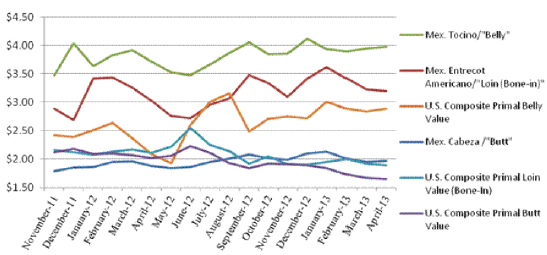



Call for Investigation into Industry Practices, Stringent Import Inspection
MEXICO - Recent news articles have decried the large volume of imported US pork and pork offals entering Mexico as a source of frustration for the local industry with elected officials and Mexican industry representatives calling for an investigation into industry practices and for stringent inspection of imported products even though year to date imports are lower than last year. Also, price data reveals that the US remains a low-cost provider of pork to Mexico and sales should be strong.Mexico is the largest volume market and second greatest value market (behind Japan) for US origin pork and pork offal. According to US Customs statistics, in 2012, the United States exported over 577 thousand metric tons of pork products to Mexico which amounted to over 26 per cent of all US pork product exports. The next closest volume market was Japan at nearly 455 thousand metric tons. By value, exports to Mexico were just over $1 billion while exports to Japan were nearly $2 billion. According to Mexican statistics, Mexican pork and pork offal exports in 2012 to all destinations almost reached 75 thousand metric tons and were valued at nearly $390 million. Mexico’s largest markets by volume and value were, respectively; Japan, the United States, and South Korea.
The United States remains Mexico’s largest foreign supplier of pork and pork offal with almost a 90 per cent market share. The next closest supplier is Canada. Over half of the imports from the United States are of fresh and chilled hams or picnic that are primarily used for the processing and manufacture of deli meat in Mexico. Nearly all of the products enter via land/border crossing points on truck with the largest crossing points being Colombia, Nuevo Leon (northwest of Laredo, Texas); Reynosa, Tamaulipas (opposite of McAllen, Texas); and Nuevo Laredo, Tamaulipas (opposite Laredo, Texas). Mexican Customs data indicates that imports of US pork and pork offals are lower nearly 5 per cent for the first two months of 2013 in comparison with the same period last year. (NOTE: US Customs statistics data is available through March 2013 and indicates that US exports for the first three months of the year are nearly 15 per cent lower than the same period in 2012).
As seen in Chart 1 below, US-origin reported ham and picnic prices, FOB Plant, remain significantly lower than Mexican national prices for comparable products and, as expected, prices recorded by Mexican customs authorities for imported US product fall between US and Mexican national prices. The data indicates that the greatest margin for products is between US and Mexican picnic with April 2012 US picnic prices just below $1.00 per kilogram and Mexican picnic a little below $3.50 per kilogram.

Source: Pierna and Espaldilla prices from Economia-SNIIM Sintesis Informativa converted from pesos per kilogram on monthly average exchange rates from Bank of Mexico, US. Composite Primal Ham and Picnic Values from USDA-AMS Livestock and Grain Market News are FOB Plant and converted from dollars per hundred weight, and trade prices from INEGI converted from dollars per metric ton.
Chart 2 below displays prices for belly, loin, and butt cuts in Mexico and from the United States. In each category, Mexican prices are higher now than US FOB Plant prices for a comparable product. However, at certain periods Mexican butt values were lower than US priced butt values indicating that there could have been an attractive market for Mexican exports.

Source: Tocino, Entrecot Americano, and Cabeza prices from Economia-SNIIM Sintesis Informativa converted from pesos per kilogram on monthly average exchange rates from Bank of Mexico, US. Composite Primal Belly, Loin, and Butt Values from USDA-AMS Livestock and Grain Market News are FOB Plant and converted from dollars per hundred weight.








